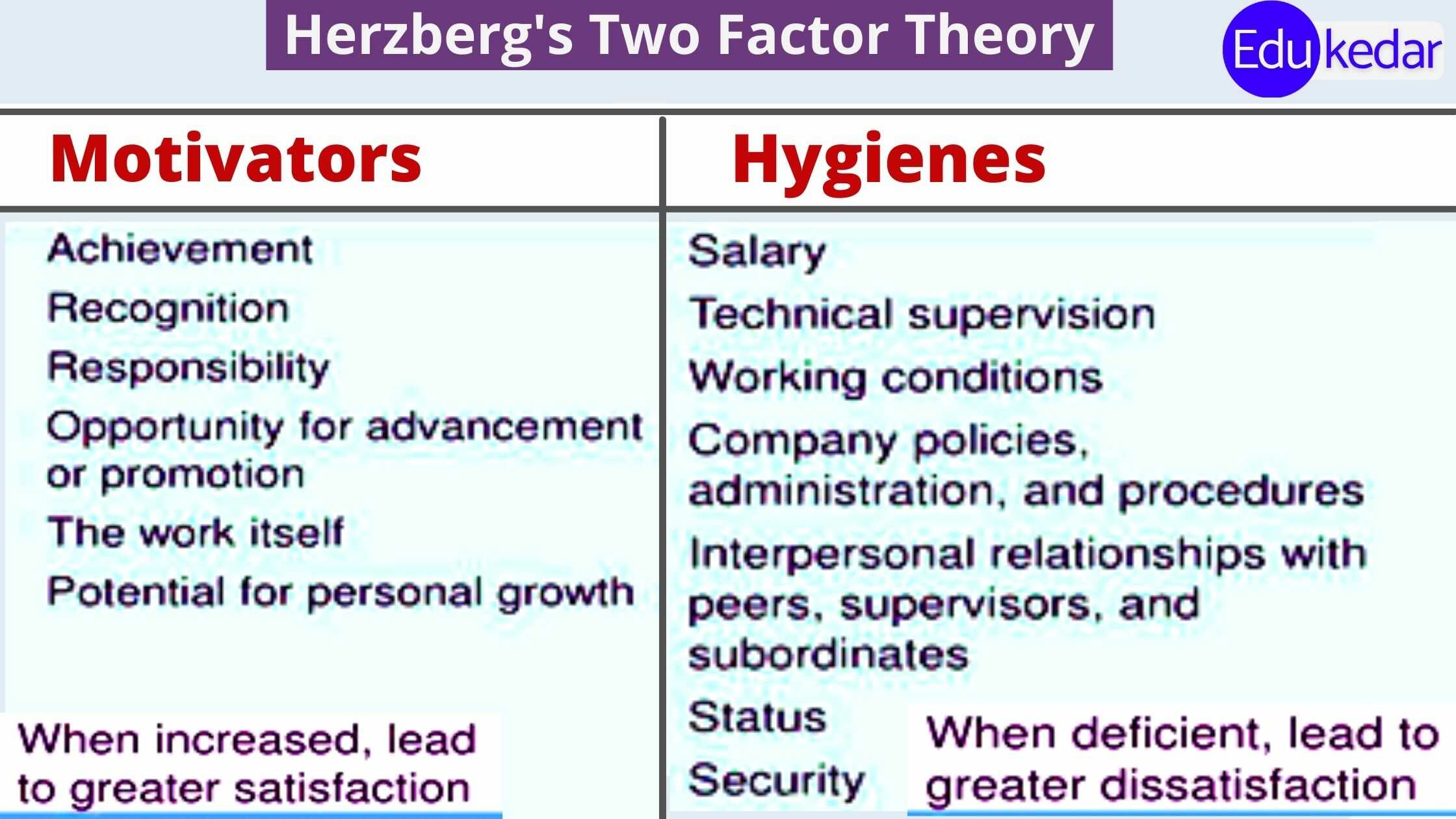Herzberg’s Two Factor Theory consists of various motivators and hygiene factors but all these factors are divided into two groups, hence is called the two-factor theory of motivation. Here we have shared the Two Factor Theory of Motivation given by Herzberg in detail.
► Herzberg’s Two Factor Theory of Motivation
Frederick Herzberg is an American psychologist who proposed the Two Factor Theory, also known as Motivator-Hygiene theory in 1959. He also introduced the concept of Job Enrichment in business management.
◉ Meaning, Definition of Herzberg’s Two Factor Theory
According to Herzberg’s Two Factor Theory, there is some work that considers that outcome satisfaction while there are other work factors that lead to dissatisfaction.
Traditional View in Work Motivation
- Opposite of satisfaction is dis-satisfaction
Herzberg’s View in Work Motivation
- Satisfaction – No satisfaction (Motivation Factors)
- Dissatisfaction – No dis-satisfaction (Hygiene Factors)
As indicated by Herzberg, the opposite to “Satisfaction” is “No Satisfaction” and opposite or contrary to “Dissatisfaction” is “No Dissatisfaction”.
◉ Explanation of Herzberg’s Two Factor Theory
Herzberg two factor theory is basically divided into two classes.
- Motivation Factors (When increased lead to greater satisfaction)
- Hygiene Factors (When deficient, lead to greater dissatisfaction)
Herzberg et. al. (1959) contends that Motivation factors are important to further develop work Satisfaction. These Motivation, as indicated by Herzberg, are natural for the gig and lead to work Satisfaction since they fulfill needs for development and self-realization (Herzberg, 1966).
Herzberg published a paper named “One More Time, How Do You Motivate Employees?” in 1968. This paper had sold 1.2 million reprints by 1987 and that time it was the most requested article from the Harvard Business Review.
In his unique paper, Herzberg inspects 14 Motivation and Hygiene factors, of which these are remarkable models.

► 1. Motivation Factors – Herzberg’s Two Factor Theory
- Opportunity for the advancement of promotion
- The work itself
- Potential for personal growth
- Responsibility
- Achievement
- Recognition
Must Read :McGregor’s Theory X and Theory Y
◉ Opportunity for the Advancement of promotion
Herzberg characterized promotion as the vertical and positive status or position of somebody in a working environment. In the interim, a negative or nonpartisan status at work addresses negative promotion.
◉ The work itself
The substance of occupation assignments in itself can have positive or adverse consequences on representatives. The work’s trouble and level of commitment can drastically affect Satisfaction or disappointment in the work environment.
◉ Possibility & Potential for personal growth
Potential for development exist along these lines as Maslow’s self-completion; they are open doors for an individual to encounter self-improvement and advancement in the work environment. Self-improvement can bring about proficient development, expanded chances to foster new abilities and strategies, and acquire proficient information.
◉ Responsibility
Responsibility includes both the obligations held by the individual and the power allowed to the person in their job. Individuals gain Satisfaction from being given the obligation and power to decide. On the other hand, a bungle among liability and level of power contrarily influences work Satisfaction.
◉ Achievement
When representatives get commendation or awards for arriving at objectives at their particular employment or for creating excellent work, they get acknowledgment. Negative acknowledgment includes reactions or fault for an inadequately taken care of business.
◉ Recognition and Accomplishment
Positive accomplishment can include, for instance, getting done with a troublesome responsibility on schedule, taking care of a task-related issue, or seeing positive outcomes from one’s work. Negative accomplishment incorporates inability to gain ground at work or helpless occupation-related independent direction.
► 2. Hygiene Factors – Herzberg two factor theory
- Interpersonal relationships with peers, managers, and subordinates.
- Salary
- Company policy, administration, and procedures
- Technical Supervision
- Working conditions
- Status
- Security
Must Read :10 Roles of Manager by Henry Mintzberg
Hygiene factors are those that reduce work disappointment. Herzberg, Mausner, and Snyderman involved the term Hygiene regarding “clinical Hygiene… [which] works to eliminate wellbeing perils from the climate”.
Herzberg likewise expresses that Hygiene factors are outward to the gig, and capacity in “the need to stay away from repulsiveness” (Herzberg, 1966).
Hygiene factors, rather than connecting with the substance of the gig in itself, will generally connect with relevant factors like relational relations, compensation, organization approaches and organization, relationship with bosses, and working circumstances:
◉ Interpersonal relations
Interpersonal connections include the individual and working connections between a representative and his managers, subordinates, and friends.
This can appear in, for instance, work-related connections as well as friendly conversations in both the workplace and during casual break times.
◉ Salary
Salary incorporates compensation or pays increments, and adversely, unfulfilled assumptions for pay or pay builds.
◉ Company Policies and organization
Company approaches and organization incorporate factors, for example, the degree to which organization association and the executive’s strategies and rules are clear or muddled.
For instance, an absence of the delegation of power, unclear approaches, methodology, and correspondence might prompt work disappointment.
◉ Supervision in Management
Supervision includes a worker’s decisions of the ability or ineptitude and decency or injustice of the manager or oversights.
For instance, this could incorporate a boss’ readiness to designate liability or to each, as well as their insight into the current task. Helpless administration and executives can diminish work disappointment.
◉ Working Conditions
Finally, working conditions include the actual environmental elements of the gig and whether or not they are great or poor. Factors leading to a decent or helpless work area could include how much work, space, ventilation, apparatuses, temperature, and security.
◉ Status
Each employee should get their status well defined and all the subordinates within the organization should be familiar and retained.
◉ Job Security
The company must provide job security to their employees so they can feel secure for their careers and future.
Must Read :Steps in Planning Process
► Advantages of Herzberg’s Two Factor Theory
- It is a judicious way to deal with Motivation. It helps in understanding the impact of occupation content on the Motivation of workers.
- It recognizes the elements that spur representatives at work and the variables that keep up with workers at work.
- It suggests explicit measures (for example Motivation) to further develop Motivation levels.
- It clarifies the meaning of occupation advancement at work upgrade and Motivation.
► Limitations of Herzberg’s Two Factor Theory
1. The two-factor theory neglects situational elements.
2. Herzberg explained a connection between Satisfaction and Productivity. In any case, the examination led by Herzberg focused upon Satisfaction and disregarded efficiency.
3. This theory’s unwavering quality is questionable. The investigation must be made by the raters. The raters might ruin the discoveries by examining the same reaction variously.
4. No exhaustive proportion of Satisfaction was utilized. A representative might secure his position satisfactory regardless of the way that he might abhor/object to an aspect of his responsibilities.
5. The two-element theory isn’t liberated from predisposition as it depends on the normal response of representatives when they have enquired about the wellsprings of Satisfaction and disappointment at work.
They will pin disappointment on the outer factors, for example, pay structure, organization strategies, and friendly relationships. Likewise, the representatives will give credit to themselves for the Satisfaction factor at work.
6. The theory disregards common laborers. Regardless of these limits, Herzberg’s Two-Factor theory is acceptable extensively.





